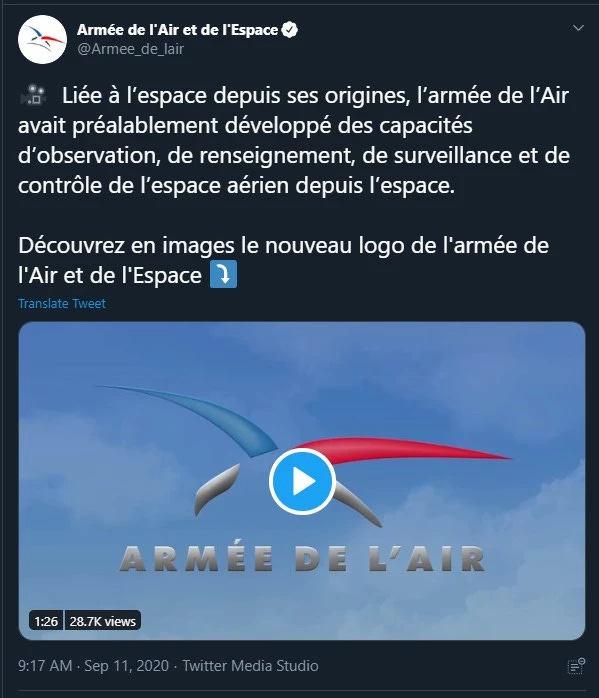France’s Air & Space Force; SMC’s Market Panel

The French (Space) Connection
Last week France renamed the French Air Force (l'armée de l'Air) to the Air and Space Force (de l'armée de l'Air et de l'Espace), which sounds awfully familiar to U.S. Air Force space operator types.

It is supposed to be a recognition of the French Space Command’s importance to the country’s national security. French Space Command was formalized a year ago. The justifications for the change to Air and Space would probably sound familiar to older U.S. space operators:
- Space intelligence/surveillance
- A changing space environment in the past ten years
- Investments in space generally and military space have doubled.
- More nations/organizations in space--over double (from 30 to now 70)
- There are more threats today in space than there were ten years ago.
- Satellites are moving in unpredictable ways.
- Satellites moving closer to French-owned satellites
- Space Defense
- Lasers (from the ground)
- Not kinetic (draws the line at orbital debris creation)
Much of the language makes it sound as if the space force is very much in a support role to the French Air Force--just like the U.S. space missions supported USAF/DoD operations. It’s interesting to see France combine its Air Force with Space, as the United States did over thirty years ago. This is because that combination was a mistake, allowing the USAF to prioritize air acquisitions and operations over space during those times. It is an Air Force, after all, and its leaders like investing in things they understand--like airplanes and golf courses.
All the above observations are to say that hopefully, the French military has taken a good hard look at the U.S. experiment before deciding to go the route it has. If it has, maybe the French believe their results will be better because...they’re French? Or perhaps, because they’re French, they just relied only on a very parochial viewpoint (just like the USAF) to determine the path leading to a combined Air/Space Force?
It could very well be that spending in the French military, on system acquisitions, training, and operations, is done very differently than in the U.S. It may be different enough that its space systems will not take a back seat to airplanes. But in my experience, a pilot in the U.S. displays very similar traits to a German or French pilot. And it seems that in France, like in the U.S.: if a pilot is in charge, then that person, however well-intentioned, will probably focus on the familiar. Even the new logo for the combined force shows this, as it’s a bird’s likeness. An excellent logo, but not appropriate for space.

France has so much excellent mid-century modern space art from which to draw. The bird (a representation of a raptor, really) seems to be a step back. Is the reorganization a similar step?
Going down this path in the United States did not help foster commercial U.S. space market growth. Other factors, ones French investors have traditionally shunned or punished, are responsible for that.
Shaping Private Sector to DoD Needs
Continuing with the USAF and space markets...the Air Force Association posted a panel, “How to align private sector with requirements of the USSF.” The panel consisted of USAF Space and Missile Systems commander (SMC) Lt. Gen. John Thompson and various C-level representatives from Boeing, Northrop Grumman, Lockheed Martin, and the United Launch Alliance (ULA).
They focused on how the U.S. government could work with space’s private sector and get the most advanced technology. While not much else was described about the panel on the AFA’s virtual Air, Space, & Cyber conference’s agenda, SpaceNews.com covered the panel.
According to SpaceNews, Thompson noted that:
“...the establishment of the Space Force presents a “unique opportunity to think differently about how this service will work with our industry partners.””
I’ve already provided a few reasons why this concept of using DoD requirements to create a commercial market is misguided. In “Help/Hindrance--U.S. Government is here to Help Commercial Launch “Market”,” which focused on DoD efforts surrounding the creation of a “launch market,” I noted:
The idea of U.S. government launches creating a “launch market” is dubious at best. Others have floated that flawed idea as an accepted gospel. I questioned it many months ago in “Is the U.S. National Security Space “Launch Market” only big enough for two launch providers?” That concept bolsters justification of the U.S. Air Force’s/Space Force’s justification for “picking winners”--even if a winner doesn’t have a mission-proven launch vehicle. It’s also what underpins opinion pieces such as Pysher’s. It’s clear from the opinion’s context that the commercial launch market not being stable is meant to be negative. But an unstable market can be positive, too.
In investing, “stable” is a term used to identify funds for the risk-averse. If a person is retiring, then shifting the nest egg over to a stable fund (or funds) is one of the more popular options to choose from. But if a person wants to have more options in life down the road (retire with the possibility of a lot of money), a little risk is involved--choosing a fund that’s not stable, but not stable in the “correct” direction--up. With stability, there is little to no growth. With no stability, there’s the possibility of great growth--and great risks as well.
This is why NSSL is not beneficial to the U.S. launch market as a whole--certainly not for the commercial part: it’s meant to capture what is good today but benefits very few in the process. The stability is a snapshot in time, freezing capabilities to shun risk, which excludes development of new capabilities and businesses. No matter what a space acquisitions program publicly states as its goal, if the words "security" or "stability" are part of it, then the words "development," "cutting-edge," and even "best" mean nothing.
Considering the panel’s members, who all lead legacy space companies, the opportunity to “think differently” seems to mean something entirely different to the AFA and SMC. Thinking differently appears in this case to involve the same companies who have failed to think differently about space technology for decades, instead focusing on the security of a bottom line underwritten by the DoD. That’s “stable” thinking, with “security” added to the mix. As noted, with stability, there is no opportunity for growth. None of the companies on this panel
The panel selection points to this type of “stable” thinking within the AFA and SMC, which is discouraging. The panel didn’t include people from SpaceX, Rocket Lab, Blue Origin, Planet, etc. You know...the companies that are changing the U.S. space industry market (although Blue Origin is iffy). Maybe AFA and SMC attempted to get them, but not one expressed interest (unlikely)? I think Elon Musk or Gwen Shotwell would have a fascinating take on DoD requirements. They might have even delivered some forceful criticism (which wasn’t offered during the panel).
The closest bit to criticism of the SF’s current approach seemed to come from ULA’s Tory Bruno, who noted that the US Space Force really should explain its needs clearly. In a way, it seemed to come across like the car dealer asking a customer, “What do I need to do to get you in this car?” Bruno’s mustache doesn’t help with this impression.
Again, it would have been a much more productive and interesting panel to have had other points of view at all in the panel.




Comments ()